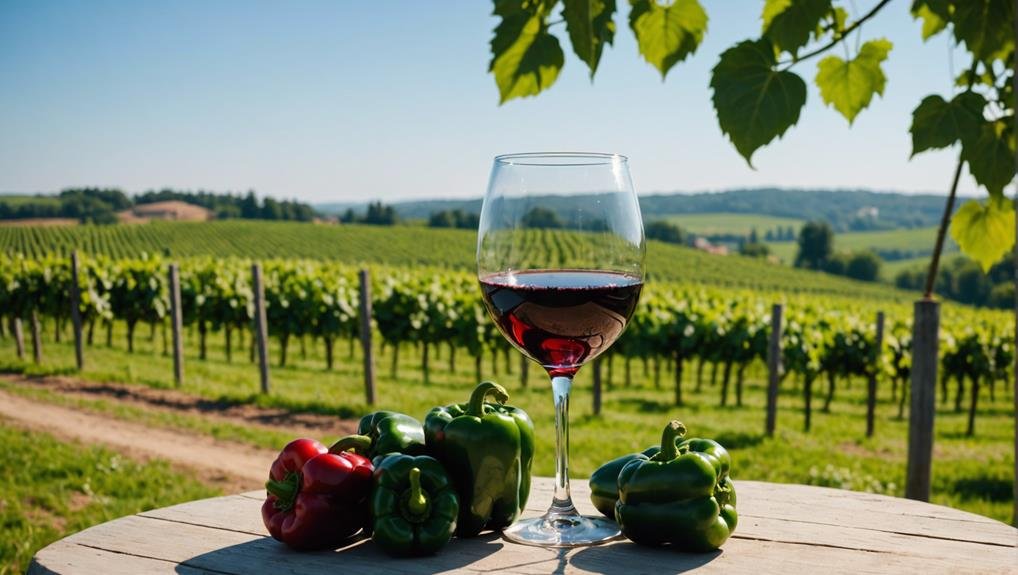Carménère, Chile's unique wine gem, offers vibrant and memorable flavors. Originally from Bordeaux, this grape thrives in Chile's climate. Carménère is known for its high levels of pyrazines, which give it distinct green bell pepper, mint, and earthy flavors. These methoxypyrazines are key to its herbaceous profile.
For wine lovers, understanding these flavors can enrich the tasting experience. Comparative tasting, especially blind tasting, can help sharpen the ability to identify these elements. If you're curious about Carménère's rich character, there's a lot to discover in each glass.
For example, try the 2018 Concha y Toro Gran Reserva Serie Riberas Carménère. This wine showcases the classic green pepper and earthy notes, with a smooth finish. Exploring different brands and vintages will give you a deeper appreciation for this distinctive wine.
Characteristics of Carménère
Carménère, often celebrated as Chile's signature grape, is known for its unique herbaceous notes and vibrant flavors. Originally from Bordeaux, this grape has found its ideal home in Chile.
Compared to its relatives, Cabernet Sauvignon and Merlot, Carménère has higher levels of pyrazines. These compounds give it distinct green bell pepper and earthy flavors. These herbaceous notes make Carménère stand out among other red wines, offering a fresh and savory taste.
Tasting Carménère provides a glimpse into the excellence of Chilean winemaking. Its complexity and unique profile make it a wine worth trying.
Aromatic Compounds
Aromatic compounds are crucial in defining a wine's character and sensory experience. In Carménère, methoxypyrazines are the primary aromatic compounds that shape its unique profile. These compounds give off aromas of green bell pepper, mint, and peppercorns, which contribute to the wine's distinct herbaceous quality.
When we compare Carménère to other Bordeaux varieties like Cabernet Sauvignon and Merlot, we see that they also contain pyrazines but in different amounts. This difference highlights why Carménère stands out with its stronger herbaceous notes.
Understanding the role of methoxypyrazines helps us appreciate the complex flavors of Carménère, making it a great choice for those who enjoy richly flavored, herbaceous wines.
Identifying Pyrazine Flavors

To truly enjoy Carménère, it's important to understand its pyrazine flavors. These flavors, especially methoxypyrazines, give the wine its unique taste. They add herbaceous notes like green bell pepper, mint, and peppercorns. By recognizing these flavors, you can better appreciate the wine's complexity.
When tasting Carménère, focus on these herbaceous notes as they enhance the wine's character. Knowing about pyrazine profiles helps you enjoy the unique sensory experience that Carménère offers. This knowledge deepens your appreciation and enjoyment of this special Chilean wine.
Comparative Wine Tasting
When we engage in comparative wine tasting, we can sharpen our ability to discern the unique characteristics of Carménère, especially compared to other wines rich in pyrazines like Cabernet Franc and Sauvignon Blanc. Blind tasting helps us focus on the sensory experience, making it easier to identify the herbaceous notes that set Carménère apart.
Here's how we can improve our tasting skills:
- Organize a blind tasting – Cover the labels to avoid any bias.
- Use tasting mats – These help us systematically assess each wine.
- Focus on aromas – Pay close attention to green bell pepper and mint notes.
- Compare with similar wines – Taste Cabernet Franc and Sauvignon Blanc alongside Carménère to highlight the differences.
When we compare Carménère to other pyrazine-rich wines, we notice unique characteristics that define each type. For example, Carménère often has distinct green bell pepper and mint aromas, while Cabernet Franc might exhibit more floral and herbal notes. Tasting these wines side by side allows us to appreciate these subtle differences.
Using tasting mats can help organize our thoughts and ensure we don't miss any details. By focusing on aromas and comparing similar wines, we can develop a deeper understanding and appreciation for each wine's unique profile.
Wine Folly Resources

For those looking to improve their wine tasting skills, Wine Folly offers excellent resources to enhance our understanding and enjoyment of wines like Carménère. Their tasting mats, which can accommodate up to 80 wines, help organize a detailed sensory experience. We can use these mats for blind tastings to identify the unique herbaceous notes of Carménère.
Wine Folly also provides a wine aroma wheel, a great tool for identifying specific scents and flavors, like green bell pepper and mint, which are linked with pyrazines. Subscribing to the Wine Folly newsletter keeps us informed with valuable wine knowledge, making it easier to elevate our wine education and appreciation.
Conclusion
Exploring Carménère reveals its unique charm and complexity. Did you know that 98% of the world's Carménère is produced in Chile? This highlights its importance in Chilean winemaking.
By understanding its pyrazine-driven flavors, we can better appreciate its herbaceous notes and rich history. Comparative tasting can deepen this understanding, making Carménère an exciting choice for wine lovers.
Let's keep enjoying this hidden gem and appreciate Chile's special contribution to the wine world.
